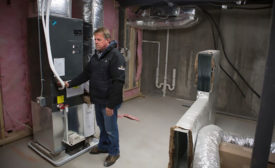Articles by Joe Marchese
Troubleshooting Reasons for Failing Start Capacitors
Tips for troubleshooting possible causes and best practices for replacing
Read More
Grounding Electrical Components
That ground wire is there for a reason: to protect you and others who work on the system
Read More
Properly Applying the Touch Test
Understanding temperature relationships can provide a ‘first glance’ into system troubles
Read More
Getting the Most Out of HVAC Manufacturer Tech Support
It’s a two-way street when technicians contact a manufacturer’s adviser for assistance
Read More
Causes of and Cures for an Iced Evaporator
Practice patience and examine the pattern of the icing before acting
Read More
Equipment Placement is Important When it Comes to Walk-ins
Location of the condensing unit and evaporator are key to a successful installation
Read More
Copyright ©2025. All Rights Reserved BNP Media.
Design, CMS, Hosting & Web Development :: ePublishing










